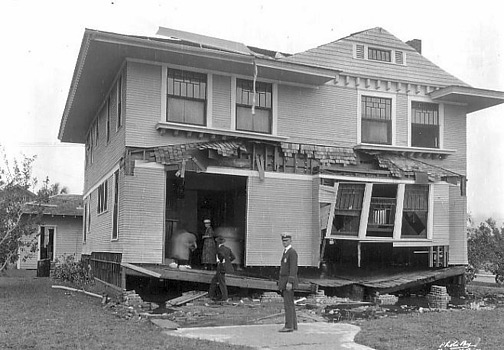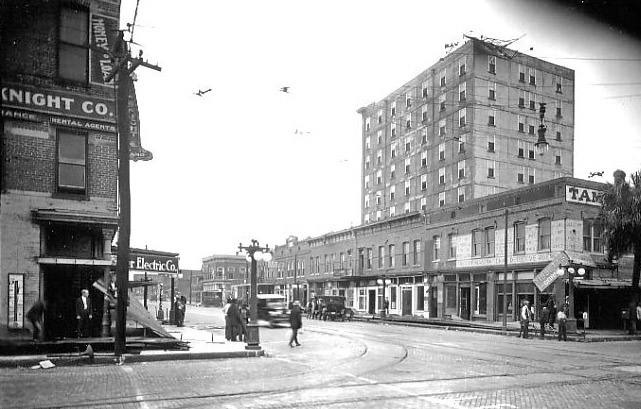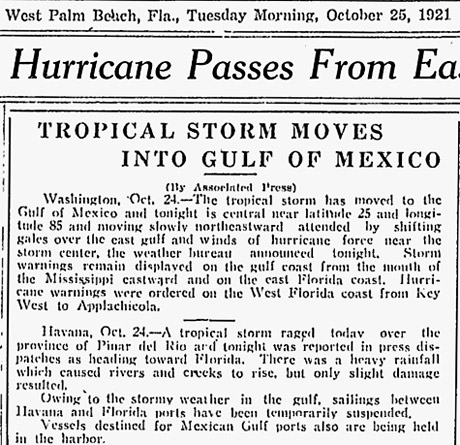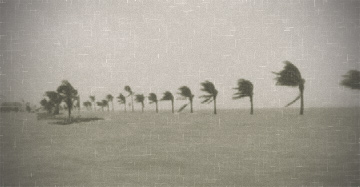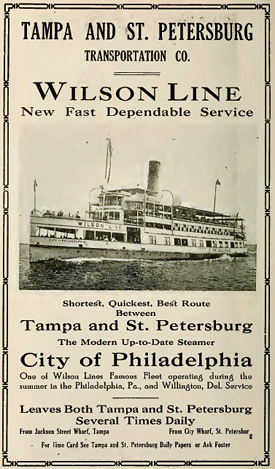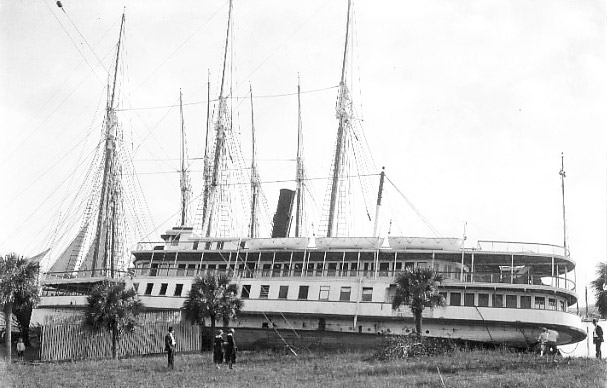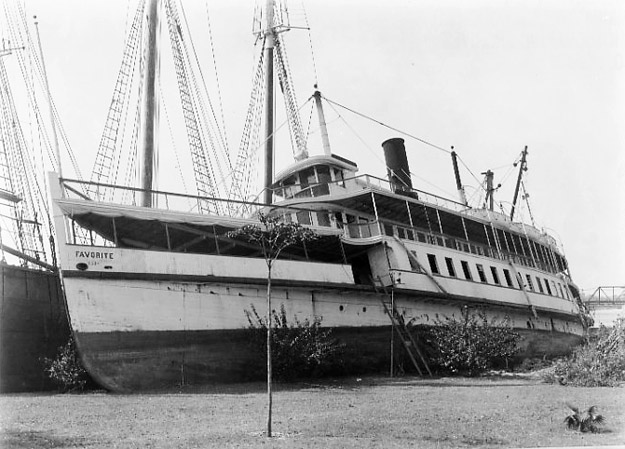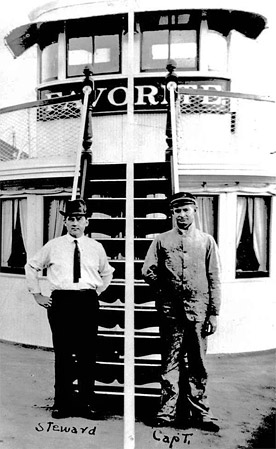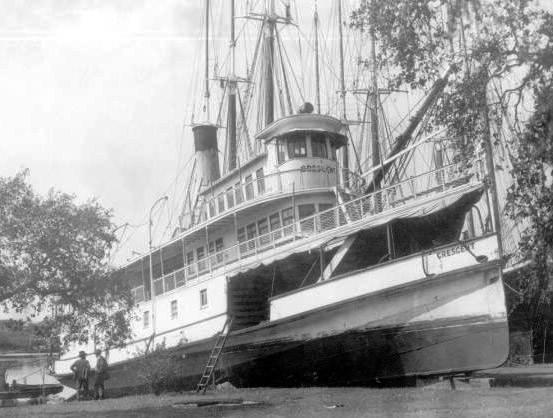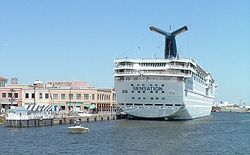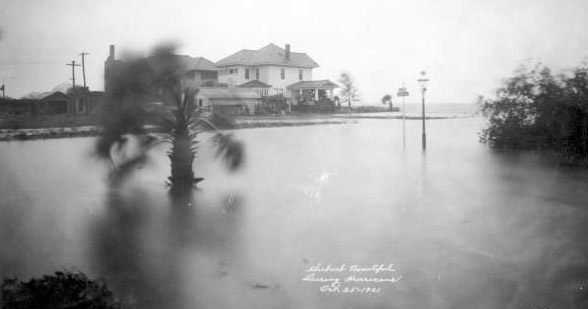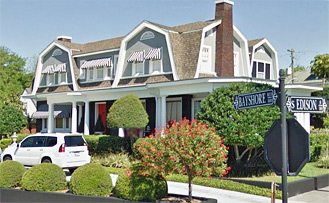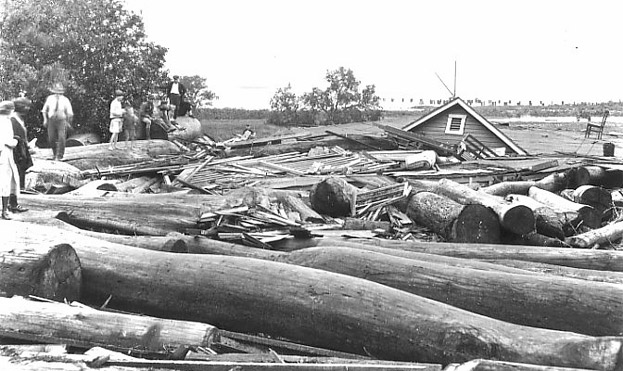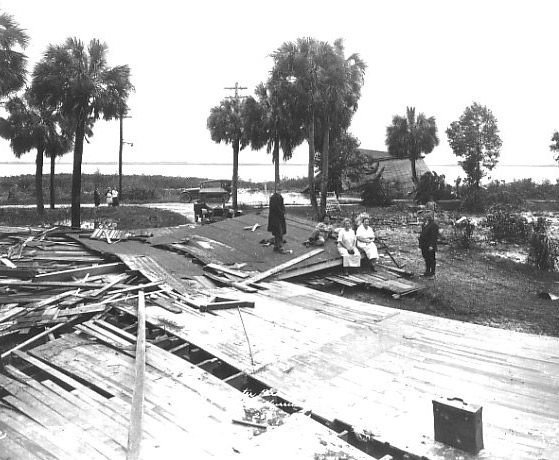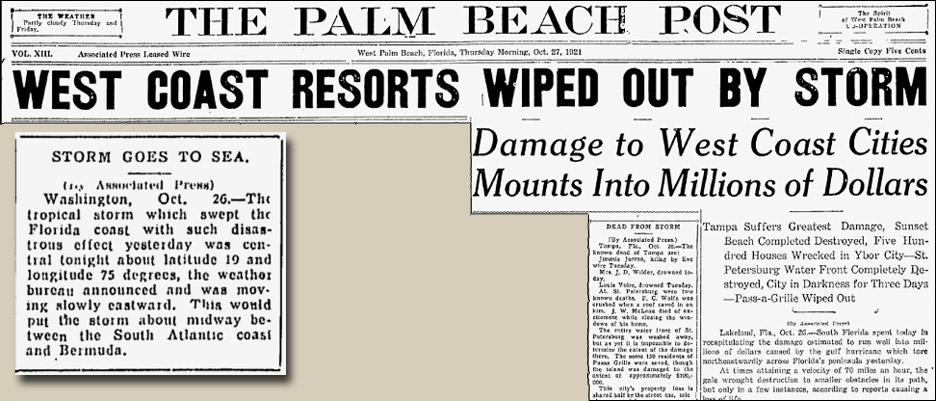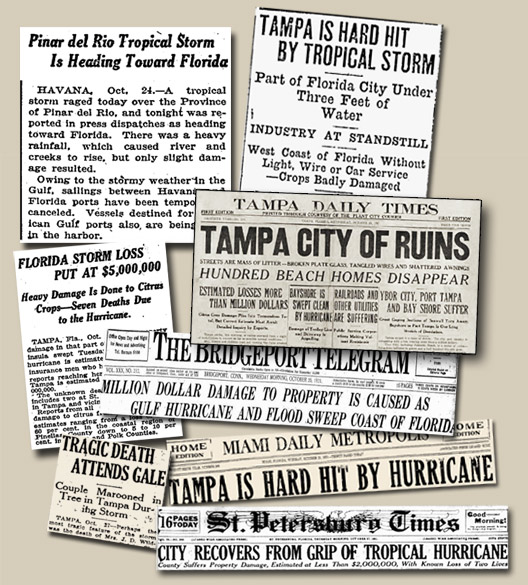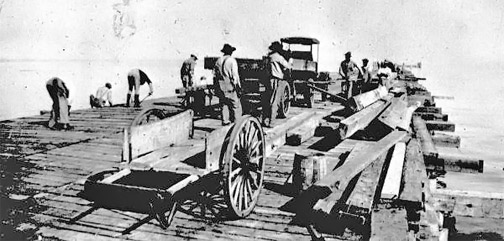 |
|
|
|
The Tampa Hurricane of 1921 (also known as the Tarpon Springs Hurricane) was the third hurricane, second major hurricane, and final storm of a relatively inactive 1921 Atlantic hurricane season. It was the first hurricane to directly make landfall in the Tampa Bay area and one of several notable hurricanes to make landfall in Florida. Numerous articles have been written in local papers and on the Internet in recent years, often claiming the wind speeds were upwards of 100mph to 140mph. The account below comes directly from the local weather station reports gathered by the Weather Bureau in Washington D.C in Nov. of 1921. Here, the winds at landfall were what would now be classified as Category 1, the storm surge was a record-breaker.
|
|
It is
important to note that the National Weather Service in Ruskin, along
with NOAA (National Oceanic and Atmospheric Administration) has recently
completed a detailed reanalysis of the 1921 hurricane which exposes the
inaccuracies of the instrumentation and methods used during the time of
this hurricane. As a result, the track of the storm has been
slightly adjusted, and the intensity more accurately determined.
This detailed reanalysis also considered errors in intensity caused by
differences in measuring winds over open seas as compared to over land.
This reanalysis leads to experts concluding that the 1921 hurricane
reached winds of 105 knots (120mph) at landfall, making it a category 3
hurricane. Keep this in mind while reading the narrative below.
Read this detailed report 90 years after 1921 hurricane, bay area officials fear direct hit
|
|
| Kids playing on a downed telephone pole on 5th Avenue at 22nd Street in Ybor City |
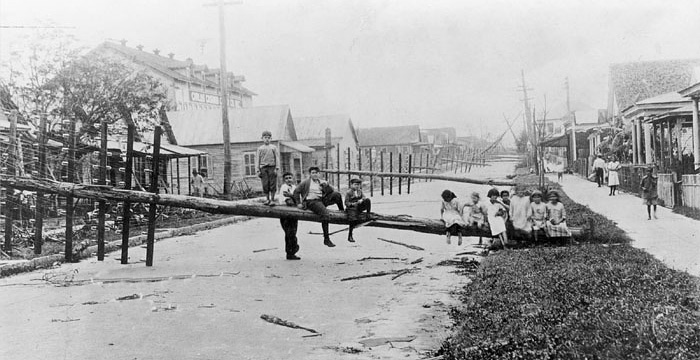 |
|
|
|
Damage to signs and awnings on Franklin Street, looking south from Lafayette Street (Kennedy Blvd.) |
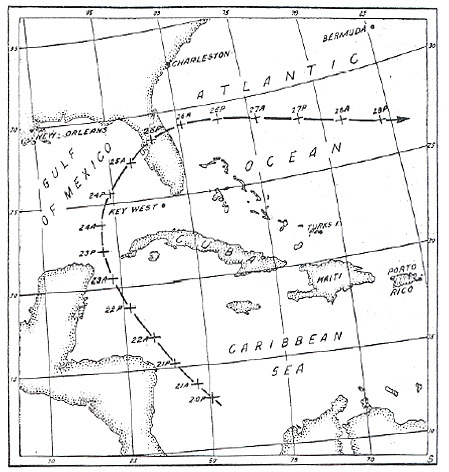 |
Meteorological information below was obtained from "Monthly
Weather Review, The Hurricane of October 25, 1921 at Tampa, Fla." by Edward H.
Bowie, Supervising Forecaster, Weather Bureau, Washington D.C., Nov. 28, 1921.
Read this publication, start at the 6th page of the PDF, page
numbered 567. Like many of the tropical storms that pop up in the Caribbean in late October, this one was no different. Late in the season known for hurricanes, the first signs of the presence of this disturbance were observed the morning of October 21, 1921. Relatively low pressure had been previously reported from bordering stations and vessels authorized to send meteorological reports by radio, and at 10am on Oct. 21, the following advisory was broadcast from the Weather Bureau in Washington, D.C.: "Disturbance appears to be forming over western Caribbean Sea southwest of Jamaica; movement uncertain, but probably northward." At the time this advice was issued, the barometer was high over the US east of the Mississippi River, low along and off the east coast, and relatively high southeast of the Bermudas. Passing north-northwestward from its initial formation, it quickly grew into a hurricane and passed near and to the east of Swan Islands on the morning of the 22nd. The barometer fell to 29.20 inches and possibly lower at that station between 10am and noon, with winds reaching speeds of 80mph.
|
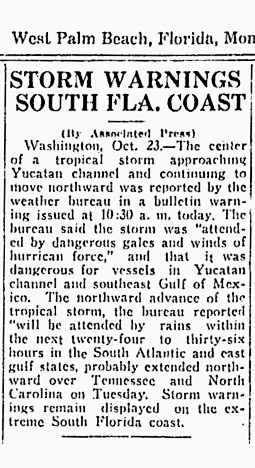
On the 23rd it passed through the Yucatan Channel west of Cape San Antonio, Cuba where it reached maximum intensity. The master of the schooner Virginia reported a minimum pressure of 27.80 inches in the center of the storm. On the 24th, it passed over the S.S. El Estero a bit northward, and the measured pressure was 27.84 inches. The U.S. Weather Bureau issued this warning on Oct. 24th: "Change to hurricane warning at noon--Key West to Apalachicola. Increasing winds and gales and hurricane velocities along the coast. Emergency: warn all interests. Tropical storm near and northwest of west end of Cuba, moving slowly northward and will change its course to north-northeastward during to-day." |
|
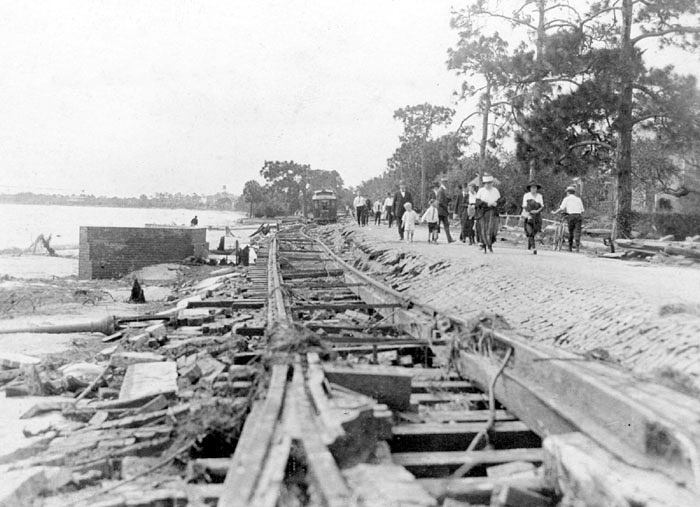
|
Trolley tracks on Bayshore Blvd. damaged when storm surge washed away the roadbed. |
|
|
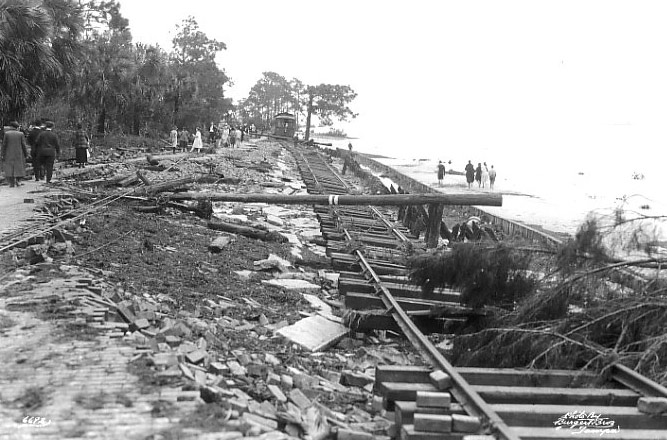 |
|
|
Local details abstracted from reports by meteorologists H.B. Boyer, W.J. Bennett, in charge of Weather Bureau stations at Key West, Tampa, repectively.
|
| Key West: Pressure steadily decreased from 29.92 inches at 10am of the 23rd to 29.55 inches on the 24th. Winds registered highest velocity on the 24th at 48mph to the southwest, then diminished gradually. Rainfall was light and intermittent. The Sand Key station 8 miles south of Key West recorded 56mph winds and lowest barometric pressure at 29.57 inches. Heavy seas from the south rolled in over the reef and practically washed away an island that had slowly built up since the hurricane of Sept. 1919. Nervous employees of the Sand Key lighthouse weather station were assured that violent winds need not be expected, but to relieve tension they were instructed to go to the lighthouse at their discretion. On the morning of the 25th, they returned to the weather station. |
Tampa: The
rains began around 4am on Sunday, Oct. 23rd and continued with hardly a
break until 9:15pm of Tuesday, the 25th. The barometer fell slowly at
first, then more rapidly after midnight of Monday, the 24th. At the
nearing of the storm, tides in the bay fell gradually, from 7 tenths of a
foot on the 24th, to zero at 2pm. During the night the bay began to
rise and reached 3.6 feet above normal, continuing to rise and at 8am on the
25th, further reading could not be obtained, the tide being over the tidal
gage. On Tuesday, the day of the storm, hurricane warnings were ordered and continued in the early morning, and distribution made as far as possible. Wires were already going down, with telephone and telegraph wires going down around noon. The winds in Tampa were steady in the pre-dawn hours of the 25th, from 25 to 42 mph and from the northeast, until shifting to more easterly and southeasterly later in the day on the 25th. The winds reached their highest sustained velocity at 68mph at 2:18pm, with extremes at 75mph. |
 |
Devastation along Tampa's waterfront along the Hillsborough River at Garrison Channel, the Gulf terminals |
| Hurricane damage at Starbuck Remilling Company, Hendry and Knight Terminals |
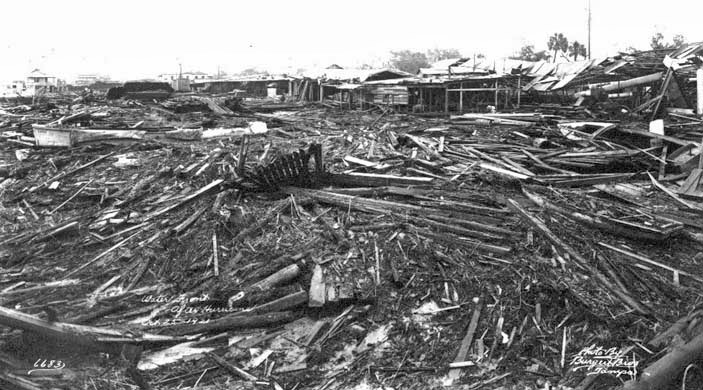 |
|
|
The "Favorite" was a was one of a number of excursion steamboats owned by the Wilson Steamboat Line. |
||||
|
|||||
| The steamboat "Crescent" run aground along the Hillsborough River in Tampa |
|
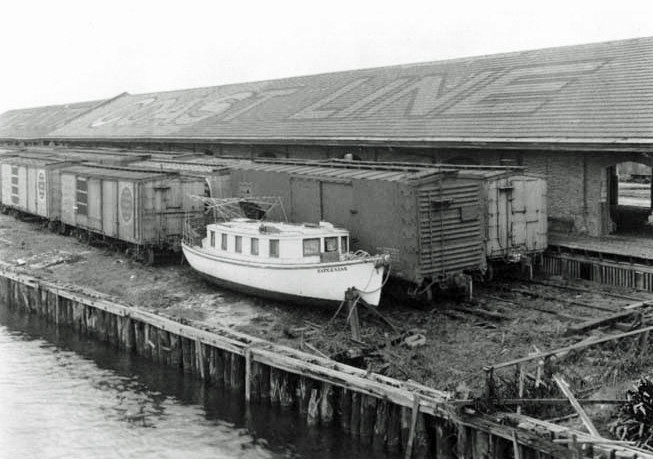
Boat, "Safe & Sane" washed ashore on Atlantic Coast Line freight depot
dock on the Hillsborough River
 |
Schooners washed onto
the wharf at Garrison Channel & Sparkman Channel with Hookers Point
in the background.
This area is now Channelside and the cruise ship terminals.
|
| The schooner Thomas B. Garland wrecked against the wharf |
 |
|
"Monthly Weather Review, The Hurricane of October 25, 1921 at Tampa,
Fla." Continued: When the storm was at its height and despite its fury, anxious visitors filled the weather office, whose employees were busy taking special observations and looking after instruments. The concerned citizens continually provided damage reports to the weather bureau workers and brought news of the brave work of those who were assisting unfortunates to escape the rising tide. The highest tide was calculated later by U.S. Engineers, to be 10.5 feet above mean at 2pm. This was by far the highest ever, the previous record being 5.55 feet during the hurricane of 1848. Egmont Key and Sanibel Island were practically covered over with water. Minimum atmospheric pressure was reached on Tuesday, the 25th as the eye of the hurricane made landfall over Tarpon Springs. In Tampa, the pressure was recorded at 2:45pm to be 28.81 inches. In Tarpon Springs, the barometer read by A. P. Albaugh showed 28.12 inches at 2:15pm with dead-calm winds, the only reading to that point known to be taken directly in the eye. Albaugh reported that the calm lasted for an hour or more. An observer in Tarpon Springs was quoted as saying, "Some blue sky was seen, then the wind broke out from the west, blowing to beat the band." The lowest ever recorded in Tampa prior to this was in 1910 at 28.95 inches, though the hurricane of 1848 may have been lower. The master of the S.S. Truxillo weathered the storm while approximately 24 miles west of Egmont Key. On Nov. 22, 1921, he sent Tampa meteorologist Walter J. Bennett his log entries during the storm. Beginning with Oct. 24th at midnight and ending with Oct. 25th midnight, he made entries every 1 to 2 hours and recorded the lowest barometric pressures from on the 25th from 10:20am to 10:50am; 28.28 inches. Prior to this time, wind speeds were hurricane force from the east, dropping to dead zero at this time, then quickly resuming hurricane force afterwards from the west. By 3pm, the barometer had begun to rise as the storm turned towards the east and Ocala. By 8pm, winds in Tampa were from the west at 24mph, with gusts reaching 30mph during the night.
The total recorded rainfall in Tampa was 8.53 inches, but
it is believed that more probably fell and was blown out of the rain gage.
Tarpon Springs recorded 8.7 inches and Brooksville, 9.5 inches. |
The lack of
communication technology of the 1920s resulted in many preliminary news
reports on the 1921 hurricane damage to be quite exaggerated, especially
in regard to Pass-a-Grille being completely wiped out.
|
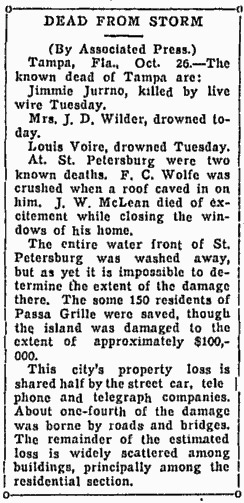 Loss of life was held to not exceeding five or six
unfortunate souls, a low figure attributed to the fact that most ships
remained in port. The citrus crop sustained a loss of 800, 000 to 1
million boxes of fruit, approximating a monetary loss of more than $1
million. The loss of trees was not great, in fact, described as
"slight." Truck crops on the coast were greatly damaged,
a complete loss in many instances, and the loss of fertilizer and labor no
doubt totaled $1 million or more. Salt water flooded many acres,
thereby rendering the soil unfit for cultivation in some instances.
The damage to residences, docks, warehouses, buildings, bridges and misc.
property from Cedar Key southward to Key West were estimated to be around
$3 million. Loss of life was held to not exceeding five or six
unfortunate souls, a low figure attributed to the fact that most ships
remained in port. The citrus crop sustained a loss of 800, 000 to 1
million boxes of fruit, approximating a monetary loss of more than $1
million. The loss of trees was not great, in fact, described as
"slight." Truck crops on the coast were greatly damaged,
a complete loss in many instances, and the loss of fertilizer and labor no
doubt totaled $1 million or more. Salt water flooded many acres,
thereby rendering the soil unfit for cultivation in some instances.
The damage to residences, docks, warehouses, buildings, bridges and misc.
property from Cedar Key southward to Key West were estimated to be around
$3 million.
[This was written in Nov., 1921. Later more recent
sources claim $10 million in 1921 dollars, $92 million in 2005 dollars,
and 8 deaths.] Nell Strickland Arnold related that she lived on DeSoto Avenue, off the Bayshore and was 7 years old at the time. They lived on an incline that sloped down to the beach on Bayshore, when there was no seawall. During the first part of the hurricane, the water was blown out of the bay. Then the eye of the storm passed over, but no one knew about the eye of the storm. It just became very quiet and calm. Everyone went outside to see the damage with roofs blown off and signs blown down. She and her father walked down to the shore and the muddy bottom of the bay could be seen for a long way out. Pianos, furniture, stoves and litter of all kinds was blown out of houses to litter yards and streets. A streetcar had gone to Port Tampa and was on the way back when it was swamped at Howard Avenue. The motorman abandoned the car and water covered the trolley, which swayed in the water. Nell and her father, and neighbors, were on the shore when the eye of the storm passed over, and the wind came from the opposite direction. It blew the water back into the bay, harder than it did the first time. The wind blew her down on the shore, the water was up to her waist and she couldn't walk. She was rescued by her father. The water came up to the first floor of homes along Bayshore.
|
 |
| In Tampa, the storm surge caused significant damage. Water submerged Bayshore Boulevard, flooding many of the the city's finest homes, washing away sea walls, downing telephone and power lines and rising above the gas lamps that lined the street. The seawall along Bayshore Boulevard was destroyed. Long stretches of the Ballast Point street car line were undermined. And the popular excursion boat S.S. Favorite was washed ashore at Plant Park. A pavilion and bath house at Ballast Point were badly damaged, and the Tampa Yacht and Country Club was severely damaged. The Ballast Point Pavilion was soon rebuilt after the storm, only to be destroyed again by fire in 1922. In 1925 a new pavilion was built. Today, the area is a city park with a fishing pier and picnic area. The Mt. Zion Methodist Church was never rebuilt after it was destroyed by the hurricane, and as a result, members attended other churches. Today, only the church cemetery is left of the Mt. Zion Methodist Church. |
 |
|
The Ballast Point Pavilion after the hurricane |
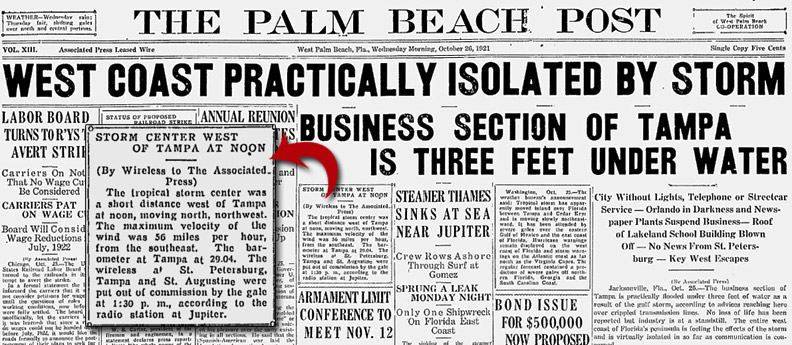
Oct. 26, 2011 Palm Beach Post
Read this paper - Note, this link is for the page preceding the
above page. You will need to advance one page to the right.
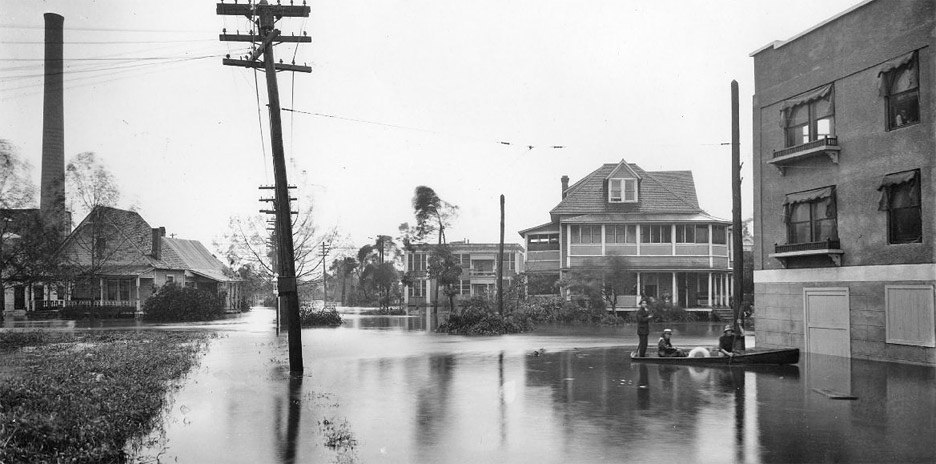
Flooding at Parker and Eagle Streets,
Hyde Park
 |
Flooding at the home of Henry Snow
at 1001 Bayshore Blvd., in Suburb
Beautiful. Below: This house today
|
| Damage to Bayshore Blvd. and the seawall |
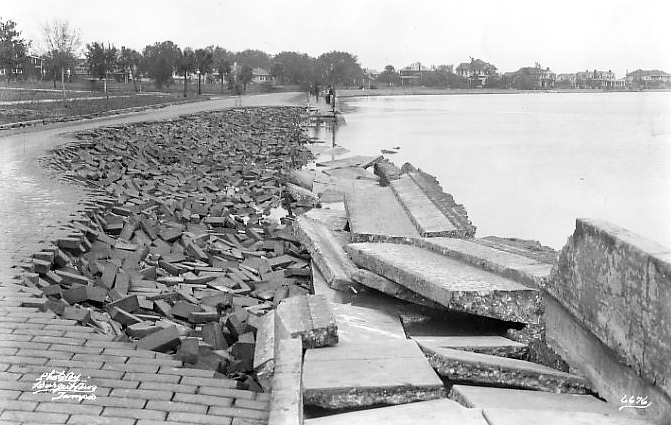 |
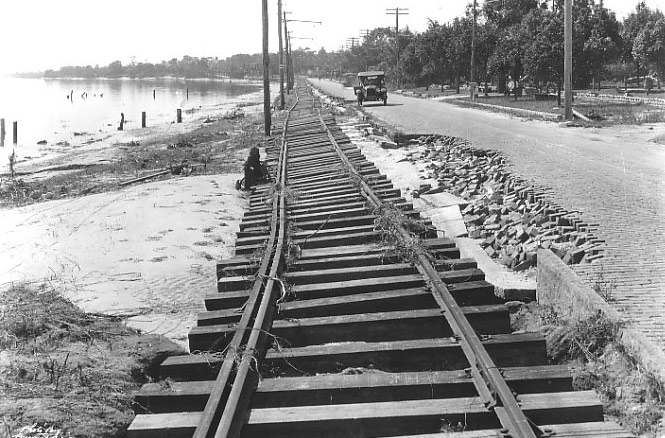 |
Damage to trolley tracks along Bayshore Blvd. |
| Damage to trees, trolley tracks, road and power lines along Bayshore Blvd. |
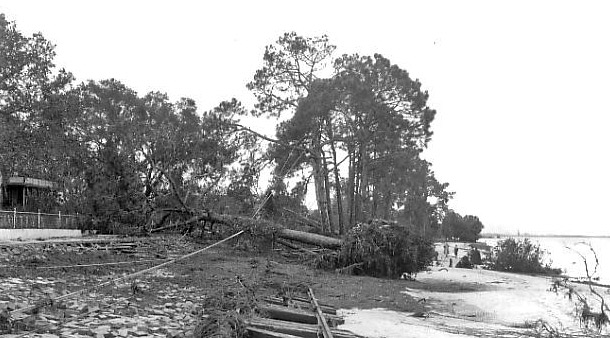 |
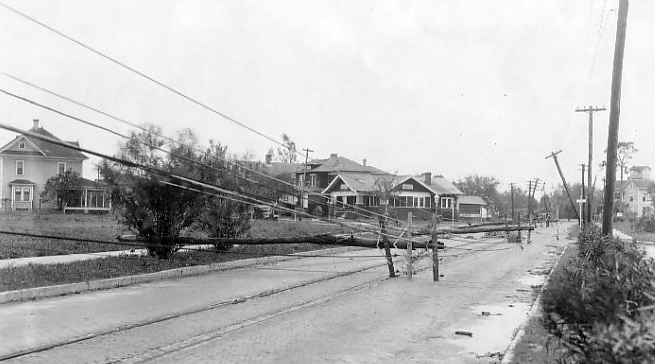 |
Downed power lines and telephone poles on South Delaware Avenue. |
|
The flooding at Palmetto Beach, Edgewater Park and DeSoto Park were even more severe than at Bayshore, due to the lack of a seawall. Homes in these areas were battered by waves and at least fifty homes in Palmetto Beach were destroyed by bashing fleets of storm-tossed cedar logs. The logs, many still chained together, were rafted off the beach while en route to the Tampa Box Company on 22nd St. in Ybor City, where they were to be made into cigar boxes. Large waves drove them onto the waterfront, smashing through walls, doors and windows of the sturdy homes along the shore. Some logs were found split open, revealing hollow chambers that held demijohns of bootleg rum, having been smuggled into the country in violation of Prohibition.
|
|
|
NEWS
REPORTS Odd occurrences were reported from all over the bay area. One Sunset Beach resident said his house started to float down the street and he finally abandoned it for the safety of a small raft. Another man, caught in the rushing tide along 22nd Street, began swimming, only to have a stray pig climb on his back. Other livestock struggled to escape the rising water; some by climbing into houses. Debris of all kinds were found in treetops, including one family's piano which was found high in a crotch of a pine tree. Numerous streetcars were washed off their tracks and found window-deep in the sand afterwards. Several residents survived by lashing themselves to palm trees and "consuming significant amounts of bootleg whiskey at hurricane parties. Rocky Point resident J. D. Wilder clung to his 85-year-old wife and a cabbage palm for most of the night as the storm surge rose around them. In the early morning hours of the hurricane's arrival, the winds and tide intensified and Wilder's wife was swept away. The Tampa Tribune wrote: "After clinging all night to a palm tree on the exposed promontory at Rocky Point, J.D. Wilder, aged 70 years, early yesterday saw his wife, aged eighty-five years, swept from his grasp, to her death in the waves. The two had clung to the tree through the long night hours . . . at last the strain was more than the aged man could bear."
|
| At
Ballast Point, Carrie Green, who had accompanied her husband to secure a
motorboat launch, was assisting her husband who was trying to repair the
boat motor, lost her mooring when she stepped on an adjacent 10-foot
skiff, and was set adrift in the boiling seas, her husband helpless to
reach her. She was swept into the bay with only one oar.
Tossed in the storm, she guided the boat by shifting her weight and was
finally washed ashore 10 miles away at Delaney Creek at was is now
Apollo Beach. According to the Tampa Tribune, "Upon reaching what
ordinarily would have been the eastern confines of the bay, Mrs. Green's
skiff kept right on going, driving into the woodland which was 6 to 8
feet under water. The skiff crashed into a pine tree and
overturned. Still clinging to the overturned boat, she swam for
about a mile, pushing the boat until she could reach bottom. She
then waded ashore, walked for another two miles until she encountered
the home of the Moyer family at 4:30am, 11 hours after she went adrift
on the Bayshore waterfront.
Above from Florida's Hurricane History, by Jay Barnes
|
Local newspapers reported the following: Tampa Tribune: "With his 2-year-old baby on his back, Frank James, resident of the Palm River District, swam ashore Tuesday afternoon in the worst part of the storm from his house, a distance estimated at least half a mile." St. Pete Times: A.R. Dunlap, a veteran Florida newsman and author of a column called "The Rambler", told of an unwary citizen in St. Petersburg, who looked up during the storm to see a piece of corrugated sheet metal flapping toward him about neck level like a scythe. "Through some freak of air current," Dunlap reported, "the wind gave the sheet iron just enough lift to clear his head as it got to him. Knocked off his hat, but could just as easily have taken off his head." From "It Could Happen Here" by D. Ballingrud, Aug. 24, 2002 |
|
|
The 1921 hurricane flooded Pass-a-Grille. The day of the storm, the St. Pete Times initially reported that Pass-a-Grille had been wiped out and that 15 to 150 people were missing. Red Cross officials loaded relief supplies and dozens of caskets on a Navy sub chaser to take to Pass-a-Grille, discovering that no lives had been lost and the rumored devastation had not occurred. The storm destroyed the wooden Casino in Gulfport and damaged the Municipal Pier in St. Petersburg. It carved Caladesi Island from Honeymoon Island, and badly damaged what was then a thriving citrus crop in Pinellas and throughout the state's midsection. It tore into the fishing village of Cortez in Manatee County very hard. Sustained winds were reported to be around 85mph, gusting to 100. It snatched away Passage Key, the small island that sits between the tip of Anna Maria and Egmont Key. |
|
COVER UP AND RECOVERY Because of fears that the hurricane might have an impact on the Florida land boom that was in its existence during the 1920s, rebuilding and cleanup of the area commenced quickly and the land boom in the Tampa Bay region and in southern Florida continued. Officials were quick to advertise that the damage was either not as bad as it was, or that reparations had been made to restore the area to the paradise it was known for before the storm. Local historian Ray Arsenault said, "In the weeks following the storm, the city was swamped with curiosity seekers, most of whom went away convinced that the city had emerged from the hurricane almost unscathed." |
|
|
City officials encouraged this thinking by making hurried repairs to the Pass-a-Grille Bridge and the Municipal Pier. "The weather was beautiful, and the sale of lots was brisker than ever now that St. Petersburg had demonstrated that it was impregnable to the forces of wind and water." Tampa residents, too, hurried to clear the streets and boasted that street cars were back in service within a day of the storm's passage. |
|
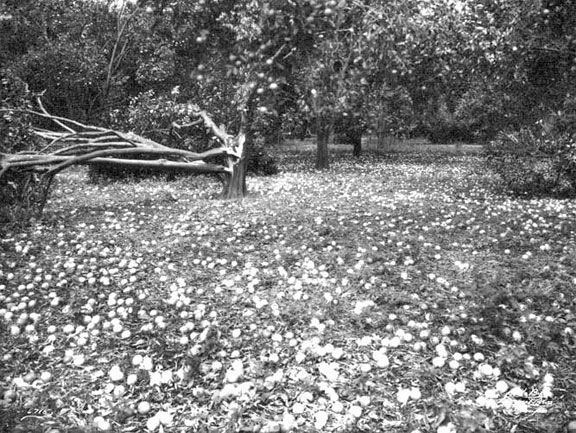 |
Fruit shippers -- the bay area had a thriving citrus industry then -- hurried to save what they could of their crops, now scattered all over the ground. "Wagons, automobiles and even wheelbarrows were pressed into service bringing fruit into the packing houses," the Times reported. "Every available fruit car on the railway . . . has been placed at the disposal of the growers, and there is not an idle man in town today." |
|
SOURCES Monthly Weather Review, "The Hurricane of October 25, 1921 at Tampa, Fla." by Edward H. Bowie, Supervising Forecaster, Weather Bureau, Washington D.C., Nov. 28, 1921 NOAA 90th Anniversary feature on the Tarpon Springs hurricane of 1921 90th Anniversary Summary
A Reanalysis of the 1921 to 1930 Atlantic Hurricane Database The 1921 Hurricane and its Effect on Tarpon Springs and Pasco County (with photos) "It Could Happen Here" by D. Ballingrud, Aug. 24, 2002 Florida's Hurricane History, by Jay Barnes |
|
 Visit
the NOAA National Weather Service Tampa Bay Area Forecast Office
Visit
the NOAA National Weather Service Tampa Bay Area Forecast Office
